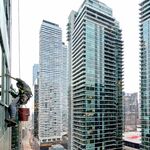This is why good design has to assume that drivers won't read signage. Signage should be there only as a confirmation of what intuition tells the driver to do.
Bad design: A sign prohibiting through traffic but having the path wide open ahead.
Good design: The path to go through the intersection is completely closed by a dead end and/or an extended median into the intersection forcing a right turn.
You can't block the streetcar tracks because streetcars and buses need to drive on them. All you can do is to block off the curb lane, which is exactly what has been done as you can see in your pictures.
Bad design: dark yellow stripes that are barely visible during the day, let alone at night that indicate a streetcar exclusive zone but that cars can just drive through and even wait in.
Good design: harsh rumble strips or a raised island inside the exclusive streetcar lane at intersections that would make it immediately obvious to drivers that they can't drive there forcing them into the turning lane.
A significant percentage of rush-hour service is operated by buses rather than streetcars, due to the streetcar shortage. But even once Bombardier delivers the new fleet it would be wise to maintain a useable route for replacement buses. Any physical modifications will need to ensure that buses can still comfortably and safely use the streetcar lane.
Bad design: a solid green light ahead, even though transit is the only one who can use it.
Good design: a transit labelled green light and a right turning green light. Drivers would never see a straight green.
To have mode-based signals, you'd need a pair of Transit Signals, a pair of Bicycle Signals, a pair of Right Turn Signals and possibly a taxi signal for after 10pm. So 6 to 8 vehicle signals per direction. Which would be a bit ridiculous for a pilot project. If the concept does become permanent
then I'd agree we should look into that. Furthermore, to increase effectiveness it would be best to have the transit signals that look nothing like the vehicle signals, otherwise drivers may just drive through during the straight green on the Transit Signal.
Also, it's important to note that a green arrow means that you can turn right
without yielding to anyone. In order to provide this, you need to have a completely separate time in the cycle for pedestrians walking straight across. This increases the delay to pedestrians, by vastly reducing the Walk duration and/or increasing the cycle length.
The city had something close to this in the Alternating Loops option but went ahead and chose the least intuitive design that relies almost entirely on drivers' voluntary compliance.
Totally agree. I was very disappointed when the City switched from the Alternating Loops design to this heavily watered-down alternative. I'm hoping that through this pilot it becomes clear that we need a more assertive version if the concept becomes permanent. A couple elements I'd like to see revived is the car-free block between University and York, and the car-free block between Church and Jarvis. The Jarvis block in particular would really help avoid any infiltration into the pilot area from the west
A design that requires constant enforcement is destined to fail. Toronto Police have only committed a presence during the first 2 weeks and yet, even with cops watching them at the intersection last night, people were breaking all sorts of rules.
This does not look good and it was entirely predictable.
By this standard, we should never have bike lanes, bus lanes or any other kind of reserved lane because they require constant enforcement to be effective. I certainly agree that the first priority should be to make a design where the rules feel natural to obey and very wrong to disobey, but there will always be a need for enforcement, especially in a hectic downtown area.





